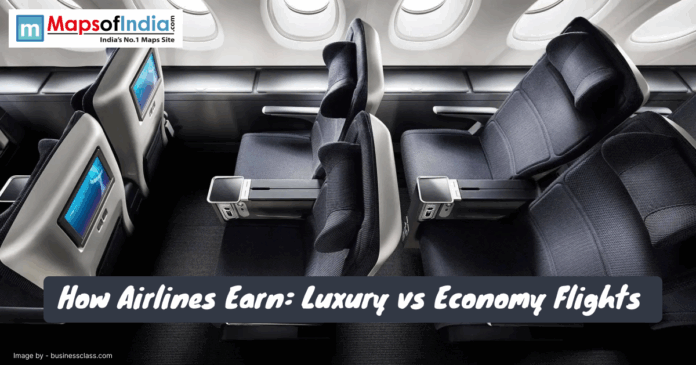The airline business is done on diverse revenue streams. The flying experience is divided into Luxury and Economy flights, which play key roles in its business module. Nowadays, air travel is booming globally. Many airline services like Emirates and IndiGo balance premium and budget offerings. Luxury cabins promise to give exclusivity to the customers. Economy seats drive volume. Both cater to different travellers. The choice depends on the reason for your flight. Understanding their strategies reveals how airlines profit.
Luxury Flights: High Margins, High Costs
Luxury flights generate significant profits for the airline. First-class and business-class seats are considered the premium seats. According to the IATA report, it has been estimated that 30% of airline revenue is generated from 5% of passengers. Emirates’ A380 suites offer private cabins on the plane. Qatar Airways’ Qsuite boasts of its lie-flat beds. The ticket cost for these premium seats is nearly $5000-$20000 for long-haul. High fares give passengers lavish amenities. Gourmet meals and fine wines are standard things you can enjoy. Dedicated lounges add exclusivity to this experience. But costs are really high. According to the CAPA Aviation article, the crew on these flights receive higher training. Luxury cabins demand space, and less number of seats. Profit margins reach 20 to 30%. Premium travellers fund airline growth.
Economy Flights: Volume Drives Revenue
Economy class is the backbone of the flying industry. These flights fill planes with as many seats as possible and generate maximum revenue. According to the recent Statista report, more than 80% of passengers fly economy. Tickets for these flights range from $100-$1000. IndiGo’s low-cost model thrives on these flights. High seat density boosts earnings. An Aviation Week article notes 180 seats on an A320. Minimal customer services keep costs low. If passengers want to have a meal, they need to pay for extras. Load factors average 85%. The economy relies on volume and not margins. Budget carriers dominate short-haul routes. Consistent demand for these flights ensures steady cash flow. The economy keeps airlines afloat.
Ancillary Revenue: Boosting Both Classes
Ancillary fees are the main part of the profit generated by these airlines. Both luxury and economy passengers contribute to this. Baggage fees, seat selection, and meals add up. According to the IdeaWorks report estimates $100 billion globally. Economy travellers also pay for checked bags. Ryanair, known for its cheap flight rates, charges €20 per bag. Luxury passengers buy the right to priority boarding. Emirates’ lounge access costs $150 extra. The In-flight Wi-Fi and duty-free sales are growing. According to the Forbes article, ancillaries generate more than 15% of revenue for the airlines. Low-cost flights are leading this trend. Extras offset low fares. Both classes drive this revenue stream.
Pricing Strategies: Dynamic and Tiered
Airlines give passengers dynamic pricing. The airline fares change based on the demand for the flight to the destination. Economy tickets see a surge during the holidays. A McKinsey report notes AI-driven pricing models. There are algorithms that track booking patterns. Luxury fares stay high with the promise of exclusivity. Business-class seats rarely get any discounts. The economy flights give early-bird deals. Basic economy flights don’t give any perks for lower costs; they charge for flying. Premium economy bridges the gap. It provides more legroom for 20% higher fares. Pricing balances demand and profit. Both classes rely on this strategy.
Operational Efficiency: Balancing Costs
Efficiency is also responsible for the airline’s earnings. Luxury cabins need more crew. According to the CAPA report, airlines require one crew per 10 premium passengers. The economy flights use one per 50. Fuel costs hit both classes hard. An IATA article said that 25% of the operating cost of the airline is fuel. Wide-body jets for luxury routes burn more. Narrow-body planes like the Boeing 737 suit the economy. Turnaround times also matter. Budget airlines are done with cleaning in 25 minutes. Luxury services have slow operations. Maintenance costs vary by aircraft age. Efficiency maximises profits across classes.
Customer Experience: Loyalty vs Affordability
Luxury flights prioritise providing the best experience of flying. For example, Emirates offers in-flight showers. Singapore Airlines provides Krug champagne. A Travel Weekly report says loyalty drives premium sales. Frequent flyers chase miles. Business travellers want a comfortable flying experience. The economy class flights focus on affordability. Flights’ on-time schedule record builds trust. An Aviation Week article notes 90% punctuality. Budget travellers tolerate less legroom in economy flights. Loyalty programs reward both classes. Miles can be redeemed for upgrades or free flights. Experience retains high spenders. Affordability keeps economy seats filled.
Market Segmentation and Global Trends
Airlines target different kinds of markets. Luxury targets to corporate travellers. Wealthy tourists also splurge. According to the recent Deloitte report, business travel accounts for 60% of revenue generated by premium flights. The economy serves leisure travellers. Families and students want low fares. Asia-Pacific leads economic growth. A Statista report says more than 4 billion passengers fly each year in economy. Middle East carriers dominate luxury. Emirates and Etihad set standards. Urbanisation boosts short-haul economy flights. Global recovery post-COVID fuels demand. Segmentation ensures both classes thrive. Airlines adapt to travellers’ needs.
Why Luxury and Economy Coexist
Luxury and economy flying experiences are complementary. Premium cabins fund innovation. According to the Forbes report, first-class profits subsidise routes. The economy flights ensure high load factors. Both of these models balance airline finances. Luxury flights attract passengers with high spending power. The economy captures mass markets. Wide-body jets serve long-haul luxury. Narrow-body planes are used for economy routes. Ancillaries are necessary for both. Dynamic pricing optimises earnings. Customer loyalty spans classes. Airlines need both to succeed. This synergy drives global aviation.
Conclusion
Airlines earn by keeping their strategic balance. Luxury flights give high margins. Economy flights work on volume and stability. Ancillaries like baggage fees are important parts in generating revenue. Dynamic pricing maximises fares according to the season. Efficiency keeps costs in check. Customer experience builds trust with the airline. Market segmentation targets diverse travellers. Luxury and economy travelling experiences coexist for profit. Many airlines provide both services. Both classes fuel growth and innovation. Understanding their roles reveals aviation’s complexity. Travellers benefit from choice. Airlines thrive on this dual model. The skies stay busy because of it.





